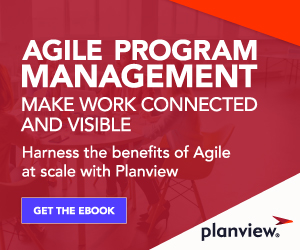![Agile Program Management: How to Increase Agile Scaling Success [Video]](https://blog.planview.com/wp-content/uploads/2020/09/Apm-video.gif)
What is Agile Program Management and how can you use it to scale Agile successfully? Planview has created a short video introducing the topic. It sets the stage for our six-part guide, which is summarized below.
First, scaling Agile means extending Agile principles beyond software development and IT to teams across the business, both vertically and horizontally. It’s not just about creating more efficient teams: it’s about differentiating the business. By using Agile frameworks and techniques, the organization can create value for customers faster.
Introduction to Agile Program Management
The video and introductory article focus on defining Agile Program Management, the key concepts, and the roles involved in practicing it effectively. Agile Program Management is how Agile organizations plan, launch, and execute initiatives in a complex, iterative environment. The practice emphasizes the delivery of value for teams, stakeholders, and organizations and is enabled by four roles or “Agilists” – Product Manager, Release Train Engineer or Program Manager, Systems Architect or Engineer, and Business Leader.
Agile Program Management is critical in scaling Agile, because managing the work of interrelated teams is complicated. As pockets of Agile form in an enterprise, teams are isolated units and can apply Agile principles in a fairly straightforward manner. As Agile starts to grow across an organization, scaling it is not as simple.
This is about transforming how an entire organization thinks and works.
Here are the six factors involved in successfully scaling Agile with Agile Program Management, as covered in our guide:
Part 1: What are Agile Release Trains?
This article defines an Agile Release Train (ART) as a collection of stable and persistent Agile teams that coordinate, plan, and manage their work on the same delivery cadence. Aligned to a common goal of delivering value that scales at the enterprise level, ARTs are the foundation for scaling Agile. Leaders of the ART – release train engineer or program manager, and executives – focus on ensuring the work delivers value and is aligned to the most important strategic objectives.
Part 2: Agile Teams: Dependency Management and Visualization
It’s easy for any set of multiple teams to have conflicts over resources, budgets, or the work itself. Dependency management is the process of actively analyzing, measuring, and working to minimize the disruption caused by intra-team and/or cross-team dependencies. This article discusses how to identify, map, and manage dependencies to increase agility and reduce waste inside Agile teams. Visualizing dependencies allows everyone involved to better align and prioritize their portion of the work. Agile program management is critical here for handling any cross-team roadblocks.
Part 3: Lean Metrics to Improve Flow
In this section, seven metrics are presented to optimize the flow of work. “Flow” – the way work progresses through a system – is essential for faster and more reliable delivery. But the main goal is consistently creating economic value. Using tools such as Kanban boards, teams can visualize how work is flowing through their system, understand their capacity, easily identify problems, and focus on getting work flowing again.
Part 4: Agile Metrics vs. Lean Metrics
Agile and Lean metrics are more alike than not. This article explains the major differences between them and their collective purpose: To quantify team performance and provide actionable insights for how to improve. In addition, both Lean and Agile metrics are used in conjunction with business metrics. Using them effectively, ARTs can deliver more effectively, drive continuous improvement, and sustain their Agile programs.
Part 5: Scaling Agile: How to Overcome 3 Common Challenges
Different scaling Agile frameworks can smooth the process, but there are three challenges leaders face when trying to implement Agile enterprise-wide: making shifts in the culture, in work management methods, and in technology. These can be viewed as a three-legged stool: failure to transform just one causes the entire Agile initiative to collapse. Agile program management helps the organization make these transformations successfully. The section ends with five main benefits of scaling Agile.
Part 6: Kanban Software for the Scaled Agile Framework®
Organizations new to scaling Agile often lack systems to coordinate and connect multiple teams to deliver against larger programs, initiatives, or strategies. Supporting team flexibility and autonomy often results in less visibility to connect delivery to broader strategic outcomes. This is where Kanban software supports Agile Program Management.
The right Kanban software can enable Agile at scale leveraging SAFe®. The goal is to identify potential bottlenecks in the process and fix them so work can flow cost-effectively at an optimal speed or throughput. The ideal Kanban software supports at the portfolio, value stream, program, and team levels to enable adaptive planning and better decision making throughout the delivery process.
Agile Program Management means embracing an adaptable, iterative approach to constant change, a collaborative mindset, and a focus on value delivery – not just delivering projects on time and on budget. Program managers and other leaders must lose the instinct to focus on execution and empower teams to innovate and deliver value in line with strategy.
For a deeper dive about using Enterprise Kanban to connect to elevate your Agile program strategy, I invite you watch it in action by checking out the demo today.





